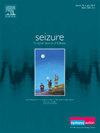CCDC22变体会导致X连锁局灶性癫痫和局灶性皮质发育不良。
IF 2.7
3区 医学
Q2 CLINICAL NEUROLOGY
引用次数: 0
摘要
背景:CCDC22 基因在调节 NF-κB 通路方面发挥着重要作用,而 NF-κB 通路是神经炎症、神经发育和癫痫发生的重要通路。此前有报道称,CCDC22 基因的变异与智力障碍有关。本研究旨在探讨CCDC22与癫痫之间的关联:方法:在中国癫痫基因 1.0 项目招募的不明原因癫痫患者队列中进行了基于三聚体的全外显子组测序(WES)。通过蛋白质建模分析了变异的损伤效应:在三个无关病例中发现了半杂错义 CCDC22 变体。这些变异在对照组中没有半义频率。本研究中发现的所有错义变异都被多种硅学工具预测为具有 "破坏性",并会改变与周围残基的氢键和/或蛋白质的稳定性。这三名患者患有不同严重程度的局灶性癫痫,其中一人患有难治性癫痫发作和局灶性皮质发育不良(FCD),两人的癫痫发作对抗癫痫药物有反应。值得注意的是,与严重表型相关的变体位于盘绕线圈结构域,预计会改变氢键和蛋白质的稳定性,而与轻度癫痫相关的两个变体则位于功能域之外,分子结构发生了中度改变。时空表达分析表明,CCDC22在大脑亚区的表达在胎儿期、婴儿期和成年早期有三个高峰,尤其是在胎儿期,这解释了发育异常的发生:CCDC22变异可能与X连锁局灶性癫痫和FCD有关。分子亚区域效应支持FCD的发生。本文章由计算机程序翻译,如有差异,请以英文原文为准。
CCDC22 variants caused X-linked focal epilepsy and focal cortical dysplasia
Background
The CCDC22 gene plays vital roles in regulating the NF-κB pathway, an essential pathway for neuroinflammation, neurodevelopment, and epileptogenesis. Previously, variants in CCDC22 were reported to be associated with intellectual disability. This study aimed to explore the association between CCDC22 and epilepsy.
Methods
Trios-based whole-exome sequencing (WES) was performed in a cohort of patients with epilepsy of unknown cause recruited from the China Epilepsy Gene 1.0 Project. Damaging effects of variants were analysed using protein modelling.
Results
Hemizygous missense CCDC22 variants were identified in three unrelated cases. These variants had no hemizygous frequencies in controls. All missense variants identified in this study were predicted to be “damaging” by multiple in silico tools and to alter the hydrogen bonds with surrounding residues and/or protein stability. The three patients presented with focal epilepsy of varying severity, including one with refractory seizures and focal cortical dysplasia (FCD) and two with seizures responding to antiseizure medicine. Notably, the variant associated with the severe phenotype was located in the coiled-coil domain and predicted to alter hydrogen bonding and protein stability, whereas the two variants associated with mild epilepsy were located outside functional domains and had moderate molecular alterations. Analysis of spatiotemporal expression indicated that CCDC22 was expressed in brain subregions with three peaks in the fetal stage, infancy, and early adulthood, especially in the fetal stage, explaining the occurrence of developmental abnormities.
Significance
CCDC22 variants are potentially associated with X-linked focal epilepsy and FCD. The molecular subregional effects supported the occurrence of FCD.
求助全文
通过发布文献求助,成功后即可免费获取论文全文。
去求助
来源期刊

Seizure-European Journal of Epilepsy
医学-临床神经学
CiteScore
5.60
自引率
6.70%
发文量
231
审稿时长
34 days
期刊介绍:
Seizure - European Journal of Epilepsy is an international journal owned by Epilepsy Action (the largest member led epilepsy organisation in the UK). It provides a forum for papers on all topics related to epilepsy and seizure disorders.
 求助内容:
求助内容: 应助结果提醒方式:
应助结果提醒方式:


